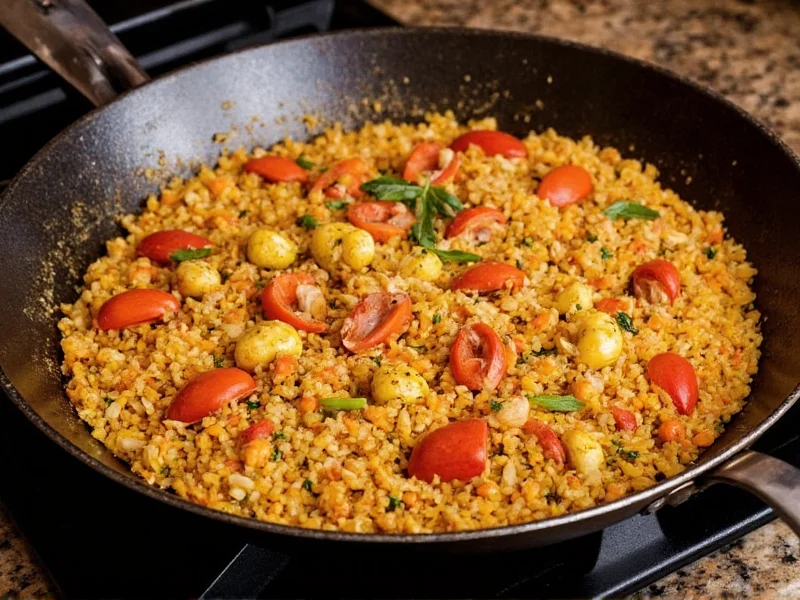Yes, you can technically use arborio rice for paella, but it's not the ideal choice. Arborio rice absorbs more liquid and releases more starch than traditional paella rice varieties, resulting in a creamier texture that differs from authentic paella's characteristic 'socarrat' (crispy bottom layer). For best results, use Bomba, Calasparra, or Senia rice when possible, but arborio can work in a pinch with recipe adjustments.
Understanding Rice Varieties for Paella
When considering whether can I use arborio for paella, it's essential to understand the fundamental differences between rice varieties. Paella, Spain's iconic dish, relies heavily on specific rice characteristics that directly impact the final texture and authenticity of the meal.
Traditional Spanish paella rice varieties like Bomba, Calasparra, and Senia have unique properties that make them ideal for this dish. These short-grain rices can absorb up to three times their volume in liquid without becoming mushy, maintaining distinct grains while developing the prized crispy bottom layer known as socarrat.
Arborio vs. Traditional Paella Rice: A Technical Comparison
| Rice Variety | Absorption Capacity | Starch Content | Grain Integrity | Ideal For |
|---|---|---|---|---|
| Bomba | 3:1 liquid ratio | Moderate | Excellent (holds shape) | Traditional paella |
| Calasparra | 2.5:1 liquid ratio | Moderate | Very good | Authentic paella |
| Arborio | 1.5-2:1 liquid ratio | High | Fair (tends to clump) | Risotto |
| Senia | 2.5:1 liquid ratio | Moderate | Good | Valencian paella |
Why Arborio Rice Changes Your Paella
The primary issue when using arborio rice for paella stems from its high amylopectin starch content—approximately 18-19% compared to Bomba's 14-15%. This extra starch creates a creamier texture that's perfect for risotto but problematic for paella, where distinct, separate grains are essential.
When home cooks search can I substitute arborio for paella rice, they're often unaware that the cooking technique must change significantly. Arborio requires constant stirring (like risotto), while authentic paella should never be stirred after the initial broth addition to develop proper socarrat.
Practical Tips for Using Arborio in Paella
If you've found yourself wondering can I use arborio rice for paella because it's what you have available, these adjustments can improve your results:
- Reduce liquid: Use a 1.5:1 liquid-to-rice ratio instead of the traditional 3:1
- Minimize stirring: Resist the risotto instinct to stir constantly
- Lower cooking temperature: Prevents the excessive starch release that creates creaminess
- Shorten cooking time: Arborio cooks faster than Bomba rice
- Add broth gradually: Unlike traditional paella where all broth is added at once
Better Alternatives to Arborio for Paella
Before settling for arborio rice in paella, consider these more suitable alternatives that maintain closer authenticity:
- Carnaroli rice: Often called the "king of rices," it has similar starch content to arborio but better grain integrity
- Calrose rice: A medium-grain option more common in the US that performs better than arborio
- Vialone Nano: Another Italian rice that works better than arborio for paella
- Suitable Spanish substitutes: Look for "paella rice" blends specifically formulated for this dish
When searching where to find proper rice for paella, check Spanish specialty markets, well-stocked grocery stores, or reputable online retailers that carry authentic Spanish ingredients.
The Culinary Science Behind the Perfect Paella Rice
Understanding why certain rices work better for paella involves basic food science. Traditional paella rice varieties have higher amylose content (the starch component that keeps grains separate) compared to the amylopectin-rich arborio.
This scientific difference explains why paella rice can absorb large amounts of flavorful broth while maintaining structural integrity, creating that signature texture where each grain remains distinct yet infused with flavor—something difficult to achieve with arborio's tendency toward creaminess.
When Arborio Might Actually Work for Paella
There are limited scenarios where using arborio rice for paella might produce acceptable results:
- Seafood paella variations: Where a slightly creamier texture complements delicate seafood
- Modern fusion interpretations: When deliberately creating a hybrid risotto-paella dish
- Emergency substitutions: When no other options are available and you adjust technique accordingly
However, for authentic Valencian paella or when cooking for those familiar with traditional preparation, arborio simply won't deliver the expected texture and experience.
Final Recommendations for Paella Rice Selection
The question can I use arborio for paella has a nuanced answer: technically yes, but with significant compromises to authenticity and texture. For home cooks seeking the genuine paella experience, investing in proper Spanish rice varieties makes a substantial difference.
If you're wondering what rice to use for paella instead of arborio, prioritize Bomba rice when available—it's worth the slightly higher cost for authentic results. When Bomba isn't accessible, Calasparra or Senia are excellent alternatives that maintain the dish's essential characteristics better than arborio ever could.











 浙公网安备
33010002000092号
浙公网安备
33010002000092号 浙B2-20120091-4
浙B2-20120091-4